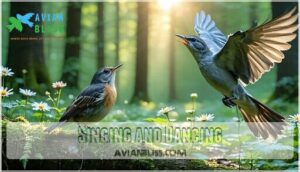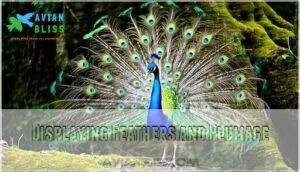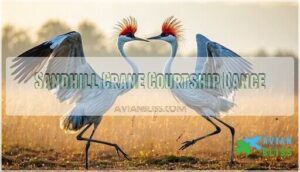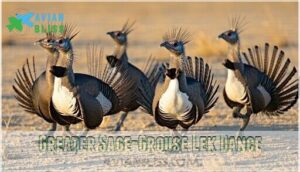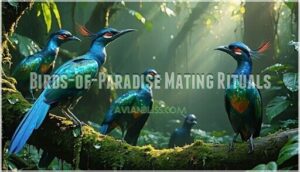This site is supported by our readers. We may earn a commission, at no cost to you, if you purchase through links.
 Bird behavior mating rituals are like nature’s most extravagant talent show, packed with flair and purpose.
Bird behavior mating rituals are like nature’s most extravagant talent show, packed with flair and purpose.
Birds use dances, vibrant plumage displays, and enchanting songs to woo potential mates. Picture the Red-Capped Manakin moonwalking across a branch or Sandhill Cranes leaping gracefully in sync—it’s romance, bird-style.
These behaviors aren’t just for show; they signal health, strength, and compatibility. Some species, like the Greater Sage-Grouse, gather in "leks," turning courtship into a group event.
From food gifts to feather flares, each ritual reflects a bird’s unique way of saying, “Pick me!” Nature’s creativity knows no bounds, and every species has its twist.
Table Of Contents
- Key Takeaways
- Bird Mating Rituals
- Courtship Displays
- Bird Species Rituals
- Mating Strategies
- Unique Mating Characteristics
- Frequently Asked Questions (FAQs)
- How do birds act when they want to mate?
- Do birds practice mating rituals?
- What do birds do before they mate?
- What are the mating strategies of birds?
- What are bird mating rituals?
- What is bird mating?
- Why are courtship rituals important in bird mating?
- How do birds communicate during mating?
- Why do birds mate?
- Why do birds perform mating dances?
- Conclusion
Key Takeaways
- Birds use dances, songs, and colorful plumage to attract mates, signaling health and strength.
- Rituals like food sharing, duet singing, and elegant displays help birds form bonds and pick the right partner.
- Mating displays differ by species, from the lek dances of Greater Sage-Grouse to the moonwalking of Red-Capped Manakins.
- These courtship behaviors ensure reproductive success and the survival of future generations.
Bird Mating Rituals
You’ll find that bird mating rituals are as unique and diverse as the species themselves, ranging from acrobatic dances to elaborate plumage displays.
These behaviors aren’t just for show—they play a critical role in forming bonds, attracting mates, and ensuring the next generation thrives.
General Mating Behavior
In the context of bird mating, their behaviors can be as dramatic as a soap opera.
Pair bond types vary, from lifelong partners to brief flings.
Courtship behavior can include ritualized behaviors like allopreening or a romantic food exchange.
These avian courtship displays aren’t just for show—they’re key to forming bird mating rituals that guarantee species survival.
To showcase their fitness, males often engage in elaborate courtship displays, including dances and songs.
Importance of Courtship Displays
Courtship displays aren’t just for show—they’re like a bird’s audition for love.
These rituals signal fitness, helping potential mates decide who’s worth their time. Whether it’s dazzling dances or melodic songs, bird displays guarantee species recognition, boosting reproductive success.
Evolutionary pressures make avian courtship displays vital in mate choice. They’re nature’s way of improving the odds in bird mating rituals, ensuring reproductive success.
Types of Mating Rituals
Bird mating rituals are as varied as feathers in the sky.
Across species, courtship displays fall into fascinating patterns:
- Lek Competition: Males gather to perform dazzling shows like the Greater Sage-Grouse.
- Duet Singing & Allopreening Rituals: Partners build bonds through synchronized calls or preening.
- Food Offering & Nest Building: Sharing snacks or crafting nests proves resourcefulness and care.
Courtship Displays
You’ll find courtship displays fascinating as birds use these spectacular behaviors to attract mates or strengthen bonds with partners.
From intricate dances to vivid plumage displays, each move reveals something unique about the bird’s fitness and intentions.
Singing and Dancing
Bird song and dance mating rituals are like nature’s finest performances.
Duet singing shows love, while song complexity showcases fitness.
Bird dances, from moonwalks to elegant leaps, reveal the evolution of courtship displays.
Many resources are available for accurate bird identification.
Here’s a quick look at singing and dancing:
| Behavior | Example Species | Purpose | Fun Fact |
|---|---|---|---|
| Vocal Mimicry | Northern Mockingbird | Attract mates, show fitness | Mimics up to 200 songs! |
| Song Complexity | Song Sparrow | Impress potential partners | Sings 20+ distinct tunes. |
| Duet Singing | Great Horned Owl | Strengthen bonds | Male’s voice is deeper. |
| Dance Evolution | Sandhill Crane | Pair bonding, coordination | Dances year-round for fun! |
Displaying Feathers and Plumage
Bright plumage and dazzling feathers make a bird’s courtship hard to ignore.
Plumage displays highlight:
- Plumage Coloration: Vibrant hues signal health and fitness.
- Feather Quality: Smoothness and shine impress mates.
- Display Postures: Birds strike dramatic poses to captivate attention.
- Iridescent Feathers: Light-reflecting colors mesmerize potential partners.
Sexual dimorphism often makes males flashier, dazzling females during breeding plumage season.
It’s nature’s version of dressing to impress!
Making Sounds and Calls
A symphony of bird communication signals can steal the show during courtship.
From the duet singing of lovebirds to intricate bird song mating displays, vocalizations captivate potential mates.
Song complexity and call variation highlight strength, while mimicry purpose impresses competitors.
Alarm calls? Not here—just irresistible serenades.
Bird courtship melodies become persuasive tools, proving charm and resourcefulness to enthusiastic listeners.
American Kestrels, for example, use distinct "klee!" calls during courtship.
Bird Species Rituals
You’ll find that bird species each bring their own flair to courtship rituals, from elegant crane dances to the quirky leaps of birds-of-paradise.
These behaviors aren’t just for show—they signal readiness to mate and help form lasting bonds.
Sandhill Crane Courtship Dance
Sandhill Crane courtship is nature’s ballroom at its finest.
An elegant dance of leaps and bows, Sandhill Crane courtship transforms wetlands into nature’s most graceful ballroom performances.
With elegant dance moves, they leap, bow, and extend wings dramatically, showcasing impressive bird courtship displays.
Unison calls echo through mating grounds, reinforcing their bond.
Even juvenile dancing plays a role, preparing young cranes for their future.
You can even find crane mating art depicting this ritual.
This unique bird dance mating ritual symbolizes connection and love in their shared Ritual Significance.
Greater Sage-Grouse Lek Dance
Gathering in a lek, the Greater Sage-Grouse males put on an unforgettable show.
With puffed air sacs and rhythmic strutting, they flaunt their stunning plumage and perfected dance mechanics. Females watch and select mates based on these performances.
To witness these displays, researchers often require specialized viewing equipment.
Tiny steps amplify the suspense. Booming calls carry for miles, and each dance reflects millions of years of display evolution. The performances are a result of millions of years of evolution, making each dance a unique spectacle, with booming calls that can be heard from afar.
Birds-of-Paradise Mating Rituals
From elaborate plumage iridescence to mesmerizing bird dance rituals, Birds-of-Paradise captivate with unmatched displays.
Males, during lek competition, showcase unique movements and poses thanks to display evolution over generations.
These striking bird courtship behaviors spotlight their physical fitness, and female choice drives this extravagance, ensuring strong offspring, though hybridization risks exist.
Territorial defense is also essential for mating success, and these birdofparadise mating rituals redefine beauty in nature with a pageant of bird mating behaviors.
Mating Strategies
In the context of mating strategies, birds put on some of the most fascinating shows in the animal kingdom.
Whether it’s offering a tasty gift, defending a prime territory, or performing an intricate dance, their goal is always the same—impressing a potential mate to achieve a successful mating strategy through fascinating displays.
Food Offering and Gift Giving
In bird courtship, males often charm females with food offers, a behavior called bird gift giving.
These nuptial gifts, like berries or insects, serve as provisioning signals, showcasing food quality and hunting skills.
Ritualized feeding strengthens bonds and influences female choice.
It’s like dinner and a movie—if the “dinner” impresses, the female may approve, advancing the mating process.
Territorial Displays and Singing
Bird song mating isn’t just music—it’s strategy.
Males compete with song complexity during dawn chorus to assert territory.
Vocal mimicry can confuse rivals, strengthening bird territoriality mating strategies.
Duet singing builds partner bonds while warding off intruders.
Territory defense through bird vocalization mating highlights a male’s stamina and resourcefulness, showing potential mates he’s got what it takes to thrive in the wild.
Elaborate Courtship Dances
Mating rituals often revolve around mesmerizing dances that showcase genetic influence and environmental impact.
Birds like Manakins and Albatrosses master incredible display complexity, blending partner synchrony with graceful moves.
These dances aren’t just for show—they’re evolution’s way of spotlighting fitness.
With every twist and hop, their courtship strategies reveal the delicate art of connection, ensuring the next generation thrives through this rhythmic display.
Unique Mating Characteristics
You’ll find that some birds have truly unique ways of catching a mate’s attention, from perfectly choreographed dances to uncanny imitations.
These behaviors, like the Red-capped Manakin’s moonwalk or the surprising role reversals of Wilson’s Phalarope, show just how creative and diverse nature can be.
Moonwalk Dance of The Red-Capped Manakin
The Red-capped Manakin’s moonwalk is pure avian magic.
This flashy display, part of intricate mating rituals, highlights their impeccable Manakin Footwork and Dance Evolution.
Using muscle memory, males glide smoothly along branches, wooing females with precision and charm.
It’s not just for show—this bird courtship dance showcases display genetics, ensuring mating success and leaving spectators marveling at such extraordinary bird behavior.
Elaborate Courtship Dances of Manakins
Manakins are the dance stars of bird courtship, combining precise footwork and energetic displays.
The Red-capped Manakin moonwalks with flair, while the Blue-backed Manakin grooves in a synchronized conga line.
These rituals, rich in dance evolution, reflect the energy spent to wow females.
Through lek mating behavior, such displays highlight health, fitness, and charm, aiding female choice while shaping mating rituals.
Variations in Mating Rituals Across Regions
You’d be amazed how bird behavior shifts across regions.
Mating rituals vary based on habitat influence, climate impact, and even genetic drift.
Birds-of-paradise, for example, showcase bold courtship performances in tropical rainforests, while Arctic terns adapt their displays to frigid environments.
Introduced species create unique blends, borrowing regional dialects from native birds. Vocal duels are common among males defending their territory.
Bird behavior studies reveal endless surprises in courtship adaptations globally, with a focus on understanding these complex mating rituals.
Frequently Asked Questions (FAQs)
How do birds act when they want to mate?
Ever noticed how birds put on a little show to find love?
They might sing a catchy tune, dance like pros, or offer food as a gift.
It’s nature’s version of dating flair!
Do birds practice mating rituals?
Of course, birds have fascinating mating rituals!
From intricate dances to food offerings and bold displays, they use these behaviors to impress partners, bond, and show readiness to mate.
It’s like nature’s ultimate dating game, with bold displays that capture the essence of their courtship.
What do birds do before they mate?
Before mating, birds turn their lives into soap operas of feathers—dancing, singing, preening, or even bringing snacks like love-struck chefs.
These rituals show fitness, build bonds, and charm their way into successful pairings, which is a result of their rituals.
What are the mating strategies of birds?
Birds use clever strategies to impress mates, from singing complex songs and delivering food to constructing intricate nests.
Some perform stunning dances or aerial displays, while others flaunt vibrant feathers, proving their fitness and charm effortlessly, showcasing their ability to attract mates through various means, including complex behaviors.
What are bird mating rituals?
Think of bird mating rituals as nature’s talent show.
From dazzling dances to sweet serenades and food sharing, birds showcase unique moves and tunes, all aimed at impressing potential mates and securing lifelong or seasonal bonds.
What is bird mating?
It’s how birds find and woo mates through dances, songs, or displays.
They show off feathers, build nests, or offer food.
These rituals strengthen bonds, attract partners, and set the stage for raising chicks together, with complete concepts like these being essential for their relationship.
Why are courtship rituals important in bird mating?
Imagine a world without handshakes or hellos—chaotic, right?
Courtship rituals in birds work the same way, establishing trust and readiness to mate.
These behaviors build bonds, showcase fitness, and guarantee the best chance of raising healthy chicks.
How do birds communicate during mating?
You’ll notice birds using songs, dances, and body displays to woo mates.
Their intricate moves and melodies act like love letters, showing off fitness and dedication, while vocal calls and gestures help reinforce budding pair bonds.
They use these displays to communicate and establish relationships, with the goal of forming a strong pair bond.
Why do birds mate?
They mate to guarantee their species survives.
It’s all about passing on their genes, finding the right partner, and raising the next generation.
Some add flair with dances and gifts, proving even nature loves romance.
Why do birds perform mating dances?
Mating dances show off a bird’s fitness and charm, like nature’s version of speed dating.
They impress potential mates while strengthening bonds through dramatic moves, colorful displays, or quirky steps, ensuring survival of the fittest pair.
Conclusion
When you explore bird behavior mating rituals, it’s clear nature isn’t shy about making a statement.
From vibrant feather displays to mesmerizing dances, these rituals aren’t just eye-catching—they’re essential for survival.
They allow birds to showcase strength, health, and compatibility, ensuring the next generation thrives.
Whether it’s the moonwalking Red-Capped Manakin or the synchronized Sandhill Cranes, each species has its unique charm.
Next time you spot a bird, consider the fascinating story behind its moves!
- https://join.birds.cornell.edu/ea-action/action?ea.client.id=1806&ea.campaign.id=24577&ea.tracking.id=LBO&__hstc=75100365.237ddccf7eb284fb9f6372467aa35c80.1557849168143.1576604739182.1576615806525.398&__hssc=75100365.3.1576615806525&__hsfp=4250418031
- https://academy.allaboutbirds.org/
- https://www.allaboutbirds.org/guide/Black-throated_Green_Warbler/sounds
- http://femalebirdsong.org/
- https://www.audubon.org/news/female-cerulean-warblers-chirp-away-birdsong-stereotypes


